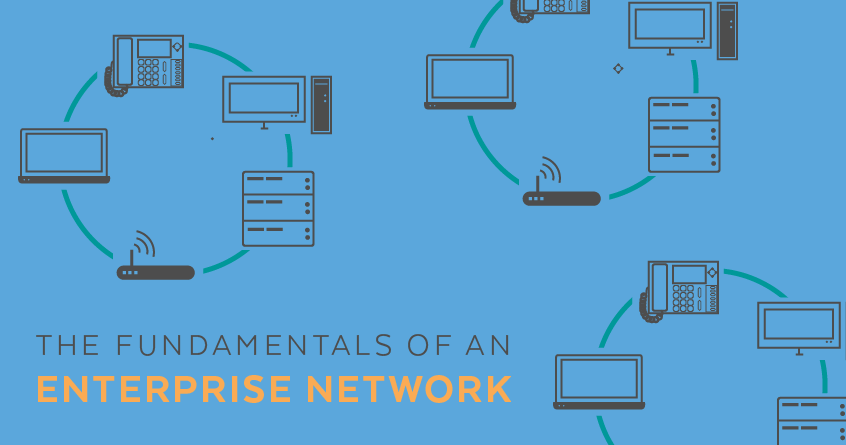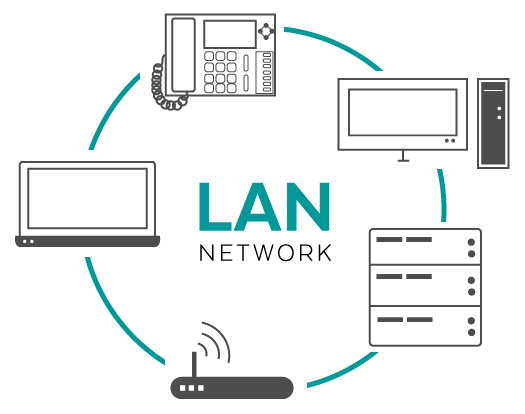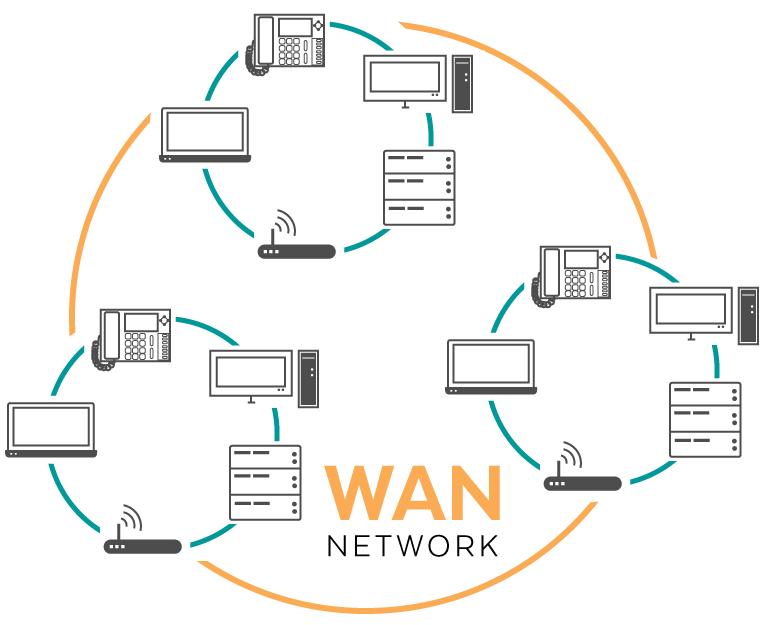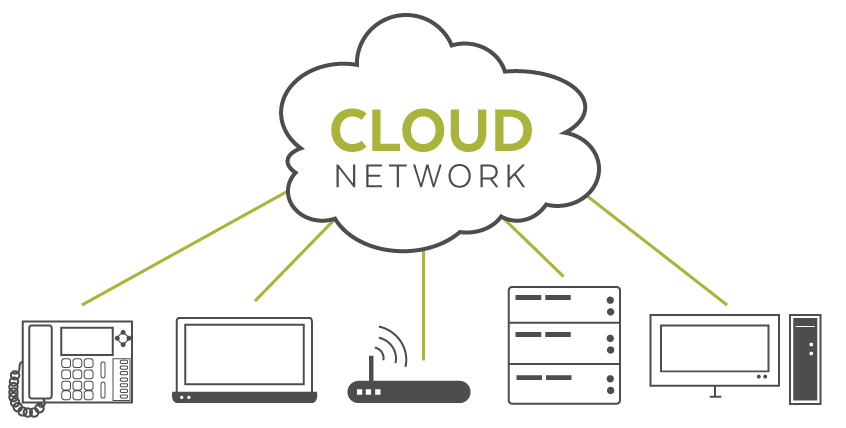The term “enterprise network” denotes a mid-size to large organizational network’s physical, virtual, and logical design. It involves how software, hardware, and protocols work together to:
- Communicate
- Share information
- Run programs
- Analyze system performance
This infrastructure is the backbone of a company’s business operations.
Today’s business world is super connected, making reliable networks imperative. Network downtime is expensive. In fact, the technological research and consulting firm Gartner states downtime costs companies an average of $5,600 a minute and can be much higher for technology-dependent organizations.
An enterprise network is complex and difficult to build, administer, and secure. Therefore, it is crucial to understand what it is and what the current trends are.
Types of Enterprise Networks
This article discusses the three most common types of enterprise networks:
- Local Area Network
- Wide Area Network
- Cloud Networks
1. Local Area Network (LAN)
A LAN contains access points, cables, routers, switches, and other connecting components in one physical location—a building, office, or home. A LAN can be large or small (e.g., an office with multiple departments and thousands of users or a small home network with just a few users). However, regardless of size, a LAN’s most defining characteristic is it is located in one single, defined area.
LANs are typically set up in an enterprise network logically or virtually (as in a VLAN). So, for example, each department (such as accounting, processing, etc.) operates on its own small LAN that connects its computers, etc., to the same switch that is separate from all the other departments.
2. Wide Area Network (WAN)
A WAN is a network that spans across many floors of a building or buildings in different geographical locations—even across the world from each other, as is common with international businesses.
In essence, a WAN is a network of networks.
WANs use different protocols and components across the Open Systems Interconnection Reference Model (OSI) layers. And while LAN technology is used for high-speed data transmission from a single location, WANs set up communication that is:
- Long-distance
- Energy efficient
- Secure
- Dependable
A WAN can be installed as either a private or public network and is most commonly set up by an internet service provider (ISP).
Please note that enterprise networks often deploy software-defined WANs (SD-WANs). An SD-WAN “ is a software-based network technology that delivers virtualized resources to wide area network connections over both ordinary broadband internet and private links. Applying the concepts of software-defined networks to WANs, SD-WAN abstracts traffic management and monitoring from network hardware and applies them to individual applications.”
SD-WANs route network traffic between data centers, branch offices, and the cloud more successfully than traditional WANs. SD-WANs are dynamic and eliminate “jitter” and dropped data packets, delivering an excellent user experience even to the most distant locations on the network.
3. Cloud Networks
Recent statistics claim that as of 2019, 94 percent of enterprises used cloud service, with a staggering 100 Zettabytes of data forecasted to be stored in cloud data centers by 2025.
Cloud networking is an IT infrastructure in which some or all of an enterprise’s networking resources are hosted in a public, private, or hybrid cloud (i.e., a combination of public or private).
Cloud networking enables large enterprises or their cloud service providers to design, configure, and manage complex networks utilizing only an internet connection. Many network resources can be hosted on a cloud, including:
- Bandwidth
- Connectivity
- Content delivery networks (CDNs)
- Domain name system (DNS)
- Firewalls
- Load balancers
- Network management software
- Virtual private network (VPN)
- Virtual routers
In addition, cloud networking offers a broad range of network security options, such as firewalls, distributed denial of service (DDoS), and AI-based threat detection monitoring.
There are two main types of cloud networking: cloud-enabled and cloud-based.
- Cloud-enabled networks: With this type of cloud networking method, the network architecture is on the enterprise’s premises, while some (or all) of the other network resources are on the cloud.
- Cloud-based networks: The entire network is based in the cloud with this method.
Why Enterprise Networks are Important
The importance of enterprise networks simply cannot be overstated. Enterprise networks enable companies with branches that span multiple cities or countries to communicate quickly and efficiently. Each organizational branch would be forced to operate in isolation without this valuable technology.
The digital-driven 21st-century business must be characterized by fast, orderly, and secure information exchange because it impacts the bottom line. The moment a network segment (or, God forbid, the entire network) goes down or is compromised, productivity takes a direct hit. It must be noted that an enterprise network seamlessly facilitates business processes such as internal supply chain, purchasing, production, sales, and distribution. Literally, every bit of data involved in a company’s business planning and execution goes through the network.
In addition, an enterprise network plays a vital role in the very survival of an organization. For example, business continuity, disaster recovery, high availability cluster nodes, and cloud-based failover servers are hugely dependent on an enterprise network to function correctly.
Enterprise Network Trends
Enterprise networks are constantly evolving. Today, most of this technology’s improvements focus on service dependability, security, and the integration of new technology standards and systems.
Let’s take a closer look at some of these enterprise network trends:
1. Secure Access Service Edge (SASE)
This cloud-based IT model bundles software with an additional layer of security for edge network technologies.
2. 5G connectivity
The adoption of the 5G networking standard will continue in the coming years. Early adopters of this technology are already experiencing significantly enhanced user experiences and high data transmission rates.
3. Wi-Fi 6 and 6E
These new connecting standards are approximately 30 percent faster than Wi-Fi 5 and are especially suited for simple in-house LAN applications.
4. Cloud
Cloud-managed WAN, SD-WAN, and Unified Communications Systems (UC) are quite popular, and increasing in use.
5. Managed-Service Providers
New service delivery methods rent advanced networking capabilities, such as Network-as-a-Service (NaaS).
6. Artificial Intelligence (AI) and Machine Learning (ML)
AI and ML are on the rise and enhance both the visibility and control of enterprise networks.
To Sum it Up
The future of enterprise networking is bright. Every organization has different needs, and in the era of digital transformation, modern enterprises can depend on software-driven solutions to power intelligent network architecture, automation, and design.
Planet Technology USA has a vast inventory of last-mile networking components. Our service is great, and we pride ourselves on helping each customer select the best product to meet their needs.
We would like to be of service. Contact us today!



